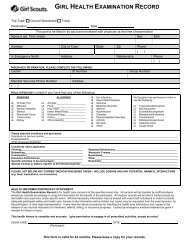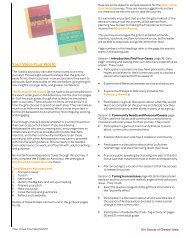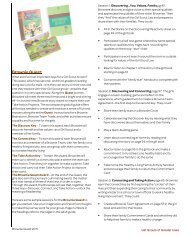forever green: celebrating 100 years of girl scouting 100 ways to ...
forever green: celebrating 100 years of girl scouting 100 ways to ...
forever green: celebrating 100 years of girl scouting 100 ways to ...
You also want an ePaper? Increase the reach of your titles
YUMPU automatically turns print PDFs into web optimized ePapers that Google loves.
FOREVER GREEN: CELEBRATING <strong>100</strong> YEARS OF GIRL SCOUTING<br />
<strong>100</strong> WAYS TO CELEBRATE THE <strong>100</strong> th<br />
This is a list <strong>of</strong> creative and fun ideas and <strong>ways</strong> <strong>to</strong> help celebrate the centennial anniversary <strong>of</strong> Girl<br />
Scouting in the United States. This is not a patch program. Have fun, good luck and enjoy the activities!<br />
PARTICIPATE<br />
• Attend a Council centennial event.<br />
• Attend a Service Unit centennial event.<br />
• Sell <strong>100</strong> boxes <strong>of</strong> Girl Scout cookies.<br />
• Have the troop sell <strong>100</strong> items in the fall product sale.<br />
• Work with another troop, at a different program level, <strong>to</strong> do a centennial activity.<br />
• Be an active member <strong>of</strong> your Service Unit by participating in a Service Unit meeting or event.<br />
• Plan and run a bring-a-friend activity for your troop <strong>to</strong> increase interest among non-Girl Scouts.<br />
• Learn about opportunities for you in older program levels and how you can stay involved once you graduate from<br />
high school and make your personal plan on how you will stay involved.<br />
• Attend a session <strong>of</strong> summer camp or plan a summer gathering for your troop.<br />
HAVE FUN<br />
• Hold a hula-hoop, yo-yo, bubble blowing or other funny competition <strong>to</strong> see if you can reach <strong>100</strong> turns, <strong>100</strong><br />
seconds or something similar without making a mistake. Award prizes.<br />
• Go bowling and have each <strong>girl</strong> try <strong>to</strong> knock down <strong>100</strong> pins.<br />
• Develop a troop <strong>100</strong>th special handshake and use it at every meeting.<br />
• Do a fun activity from an outdated Girl Scout handbook.<br />
• Play some new games outside for <strong>100</strong> minutes.<br />
• Collect signatures <strong>of</strong> <strong>100</strong> Girl Scouts (past or current members).<br />
• Sing <strong>100</strong> Girl Scout songs.<br />
• Choose a community <strong>100</strong> miles away, research it and explore it in person or virtually.<br />
• Using pho<strong>to</strong>graphs <strong>of</strong> Girl Scouts in action (current or his<strong>to</strong>rical), create a banner or picture montage <strong>to</strong> display at<br />
your <strong>to</strong>wn hall/community center commemorating <strong>100</strong> <strong>years</strong> <strong>of</strong> Girl Scouting.<br />
• What else was happening in 1912? Learn about his<strong>to</strong>rical events or inventions that share our centennial. (Hint: two<br />
states, a popular candy and a Massachusetts entertainment venue all came <strong>to</strong> be in 1912.) Celebrate one <strong>of</strong> these<br />
events with your troop or others.<br />
BE CREATIVE<br />
• Write a poem about Girl Scouting.<br />
• Draw a picture representing a favorite time or activity in Girl Scouting.<br />
• Make a trefoil or centennial piñata and break it at a centennial celebration.<br />
• Create a centennial quilt where each square highlights a Girl Scout activity.<br />
• Design and make a centennial t-shirt <strong>to</strong> wear at your meetings this year.<br />
• Make up a s<strong>to</strong>ry about Girl Scouting <strong>100</strong> <strong>years</strong> from now.<br />
• Create <strong>100</strong>th bookmarks and distribute <strong>to</strong> the school library.<br />
• Create a math puzzle based on the number <strong>100</strong>.<br />
• Make your own Girl Scout cookies using a recipe from the 1920s.<br />
• Create your own activity <strong>to</strong> recognize the centennial.
EXPLORE THE OUT-OF-DOORS<br />
• Go camping with your troop for <strong>100</strong> hours over the course <strong>of</strong> a year or attend the <strong>100</strong>th Camporee if you are old<br />
enough.<br />
• Collect or create <strong>100</strong> outdoor recipes and make a troop cookbook.<br />
• Over the course <strong>of</strong> the centennial year, walk <strong>100</strong> miles.<br />
• Attend a vacation week camp.<br />
• Learn about the stars and spend an evening studying the skies. See how many constellations you can find. Can<br />
you find <strong>100</strong> stars?<br />
• The Girl Scout Handbook Intermediate Program (1947) states: “A Girl Scout should be able at least <strong>to</strong> tie her own<br />
parcels, rope her own blanket-roll, tie up her boat, put <strong>to</strong>gether a broken string, hitch an animal” (p. 324). Practice<br />
tying at least three different knots. Have a knot tying relay race with other Girl Scouts.<br />
• In How Girls Can Help Their Country, the first Girl Scout handbook, Juliette Gordon Low wrote: “There are <strong>to</strong>o,<br />
things <strong>of</strong> the night well worth study. It is <strong>to</strong>o bad that there is such a senseless prejudice against the night air…” (p.<br />
45). Take a night hike, do some activities outside at night or lead younger <strong>girl</strong>s in exploring outdoors at night.<br />
• Identify local birds and take a birding hike or go the extra mile and complete the first step <strong>of</strong> the “Bird Hunter” test<br />
in the 1920 Girl Scout Handbook Scouting for Girls, “Give a list <strong>of</strong> 20 wild birds personally observed and identified<br />
in the open and show field notes including at least the date seen, field marks, food habits, nesting habits if known,<br />
and immigration if any” (p. 501).<br />
• The Girl Scout Handbook Intermediate Program (1947) describes a rambler as "a person who explores around,<br />
not sticking <strong>to</strong> the beaten paths, and who takes the time <strong>to</strong> enjoy things as he goes along" (p. 240). Take a ramble<br />
through an area near your meeting place or in your community. Be open-minded about your ramble location or<br />
what you might find and keep track <strong>of</strong> what captures your interest. Record your findings with words, sketches,<br />
pho<strong>to</strong>s or other media. Share what you discovered.<br />
• The Girl Scout Handbook Intermediate Program (1953) says, "In the out-<strong>of</strong>-doors when nails and hammers are<br />
not handy, knowledge <strong>of</strong> lashing is useful" (p. 274). Find out about the three types <strong>of</strong> lashing (square, round,<br />
continuous). Try one <strong>of</strong> the types. For a further challenge, make something using your lashing skills.<br />
DEVELOP YOUR POTENTIAL<br />
• Make a list <strong>of</strong> “<strong>100</strong> acts <strong>of</strong> kindness” that a person can do throughout the day <strong>to</strong> bring joy <strong>to</strong> others. See how many<br />
the troop can complete in a time period.<br />
• Design a “<strong>girl</strong> growth” plan. List a characteristic for the letters <strong>of</strong> Girl Scout (e.g. G=generosity, good grades /<br />
I=interest, inventions, ingenuity, independence / R=real friendship / L=loyalty, leadership / S=sincerity,<br />
stewardship, strength <strong>of</strong> convictions / C= courage, confidence, character / OUT=outdoor experiences, outdoor<br />
knowledge). Ask the <strong>girl</strong>s <strong>to</strong> choose the characteristic for each letter, decide how <strong>to</strong> develop the characteristic,<br />
how <strong>to</strong> measure growth, chart progress and celebrate when all the letters are completed.<br />
• Research what has changed in the lives <strong>of</strong> <strong>girl</strong>s and women in the past <strong>100</strong> <strong>years</strong>. Make a poster.<br />
• As a troop, read <strong>100</strong> books.<br />
• Go <strong>100</strong> hours without electricity/cell phone/texting/computers.<br />
• Advocate for the implementation <strong>of</strong> a recycling program where one does not exist.<br />
• Practice Leave No Trace camping on your next camping trip.<br />
• Log <strong>100</strong> hours in a new physical challenge: bike/walk/swim/dribble a basketball/jump rope, etc.<br />
• Learn a new activity such as a craft, hobby, musical instrument or learning a new language. Practice it for <strong>100</strong><br />
hours.<br />
• The Girl Scout Promise directs us <strong>to</strong> "live by the Girl Scout Law". Pick one <strong>of</strong> the laws and make an extra effort <strong>to</strong><br />
put that law in<strong>to</strong> practice in your daily life. After one month, share your experience with your troop.
MAKE THE WORLD A BETTER PLACE<br />
• Have your troop collect <strong>100</strong> items for donation (canned goods, socks, books, etc).<br />
• Pick up litter in an area around your meeting place, local park, beach or other area for <strong>100</strong> minutes.<br />
• Have your troop complete <strong>100</strong> hours <strong>of</strong> community service over the year.<br />
• Make <strong>100</strong> special treats for the kids at a soup kitchen or a senior center/nursing home for a special holiday (e.g.<br />
candy cane reindeer at Christmas, “boo” pops at Halloween, flag-shaped treats for 4th <strong>of</strong> July, Memorial Day, or<br />
Veterans Day).<br />
• Create a centennial rain garden at your school or meeting place.<br />
• Do <strong>100</strong> good deeds.<br />
• Plant <strong>100</strong> trees or flowers.<br />
• Conduct a blood drive and aim for <strong>100</strong> donors.<br />
• Create a birthday box for a local food pantry. The box would contain all items necessary for a child's birthday<br />
party (cake mix, frosting, decorations, paper plates, etc.).<br />
• The Girl Scout Handbook (1940) says, "No matter who you are or where you live, you can have a share in the<br />
satisfying experiences <strong>to</strong> be found in reading and writing" (p. 370). Spend <strong>100</strong> minutes reading <strong>to</strong> younger<br />
children or senior citizens, make books-on-tape for a preschool or child care center, or organize a s<strong>to</strong>ry time at a<br />
local library.<br />
BE PART OF THE COMMUNITY<br />
• Participate in a parade carrying a <strong>100</strong>th banner.<br />
• Work with your Service Unit <strong>to</strong> have March 12th be declared “Girl Scout Day” in your <strong>to</strong>wn.<br />
• Wear your Girl Scout uniform or pins on March 12th.<br />
• Write an article for your local paper about a family with several generations <strong>of</strong> Girl Scouts in it.<br />
• Stand in the shape <strong>of</strong> “<strong>100</strong>”, take a picture and submit <strong>to</strong> the <strong>to</strong>wn newspaper.<br />
• Help plan and attend your house <strong>of</strong> worship on Girl Scout Sunday/Sabbath.<br />
• Tell <strong>100</strong> people about the <strong>100</strong>th Girl Scout anniversary.<br />
• Write a letter about why Girl Scouting is important <strong>to</strong> you and send it <strong>to</strong> your local newspaper.<br />
• Plan an event that highlights Girl Scout activities and invite the community.<br />
• Make a trefoil using <strong>green</strong> construction paper and write the number <strong>100</strong> in the center. Display it in the window <strong>of</strong><br />
your home or meeting place during Girl Scout week (March 11-17, 2012). Or, tie <strong>green</strong> ribbons around your mailbox<br />
or trees during Girl Scout week.<br />
EXPLORE THE WORLD OF GIRL SCOUTING<br />
• Connect with a troop over <strong>100</strong> miles away.<br />
• Early handbooks included information on Morse code and semaphore. Learn about these <strong>ways</strong> <strong>of</strong><br />
communicating and try sending a friend a message in one <strong>of</strong> them.<br />
• Research and plan a meeting where all the activities are those from 1912.<br />
• Learn about a Girl Scout who is older than <strong>100</strong>.<br />
• Make a list <strong>of</strong> <strong>100</strong> famous Girl Scouts (past or present).<br />
• Explore another community in the council that you don’t know much about or have never visited by attending a<br />
council program there or by visiting a local landmark or picnic area.<br />
• What is Empress Eugenie’s Circle? Why would you do it? Get a group <strong>to</strong>gether and make one! (Hint: It’s discussed<br />
in How Girls Can Help Their Country.)<br />
• Plan and hold a flag ceremony after you have learned proper flag etiquette and how <strong>to</strong> fold the American flag.<br />
• Collect <strong>100</strong> memories <strong>of</strong> Girl Scouting. Ask current or former Girl Scouts <strong>to</strong> share their s<strong>to</strong>ries and record each on<br />
an index card. Make the s<strong>to</strong>ries in<strong>to</strong> a booklet.<br />
• How many words can you create from the letters in "Juliette Gordon Low"? Can your troop make <strong>100</strong> different<br />
words?
CELEBRATE OUR FOUNDER, JULIETTE GORDON LOW<br />
• Juliette was born in Savannah, Georgia. Cook a meal using foods Georgia is known for (peaches, pecans, peanuts,<br />
Vidalia onions).<br />
• From birth, Juliette’s nickname was “Daisy”. Create a flower arrangement that includes daisies and use it as a<br />
centerpiece for a special troop or <strong>to</strong>wn event.<br />
• Juliette’s childhood was affected by the Civil War. Girl Scouts performed important service tasks during WWI and<br />
WWII. Support <strong>to</strong>day’s men and women in the armed services by writing letters or holding a drive <strong>to</strong> collect<br />
needed items.<br />
• Daisy loved animals. Plan and carry out a service or Take Action project that benefits animals.<br />
• Juliette was a no<strong>to</strong>riously bad speller. Host a spelling bee in your troop or community.<br />
• Juliette was almost completely deaf by the age <strong>of</strong> 26. Learn about other famous women who have had physical<br />
challenges such as Marla Runyan (marathoner), Bethany Hamil<strong>to</strong>n (surfer), Jean Driscoll (marathoner), Marlee<br />
Matlin (actress) or Frida Kahlo (artist).<br />
• Juliette traveled <strong>to</strong> England where she met the Baden-Powells who inspired her <strong>to</strong> start the Girl Scouts in the USA.<br />
Find five places in England you would like <strong>to</strong> visit.<br />
• Juliette was a painter, a sculp<strong>to</strong>r and made a set <strong>of</strong> iron gates for her house. Learn some techniques in one <strong>of</strong><br />
these areas or visit the studio <strong>of</strong> an artist who works in one <strong>of</strong> these media.<br />
• Juliette sold her pearls <strong>to</strong> finance Girl Scout activities. Make a piece <strong>of</strong> jewelry using a technique or materials <strong>of</strong><br />
your choice.<br />
• Juliette died <strong>of</strong> breast cancer. Plan and carry out a service or Take Action project that benefits a group involved in<br />
fighting cancer or cancer awareness. Alternatively, attend and participate in the service project as part <strong>of</strong><br />
Scouting for a Cure.<br />
GLOBAL GIRL SCOUTING<br />
• Learn about the World Association <strong>of</strong> Girl Guides and Girl Scouts (WAGGGS), and discover and try one <strong>of</strong> the<br />
centennial activities.<br />
• Take a virtual trip <strong>to</strong> <strong>100</strong> WAGGGS member countries. Make a passport and stamp it each time you learn about a<br />
new country.<br />
• Learn at least one <strong>of</strong> the songs <strong>celebrating</strong> the world centers: the Our Cabaña Song, the Our Chalet Song, the Pax<br />
Lodge Song, or Come in <strong>to</strong> Sangam.<br />
• Learn the words <strong>to</strong> the World Song.<br />
• Learn about global travel, the Juliette Low World Friendship Fund and more through Girl Scouts <strong>of</strong> the USA Global<br />
Girl Scouting.<br />
• Learn about and plan a celebration for World Thinking Day.<br />
• Learn the symbolism behind the World Trefoil and the World Flag.<br />
• Learn about people important <strong>to</strong> international Girl Guiding/Girl Scouting. What role did the Baden-Powells<br />
(Robert, Agnes and Olave) play? Or, find out about the founders <strong>of</strong> Girl Guiding/Girl Scouting in another country<br />
such as Olga Malkowska (Poland), Antionette Butte (France) or Leang Meng Ho (Cambodia).<br />
• Not all WAGGGS countries use Daisy, Brownie, Junior, etc. <strong>to</strong> name their age levels. Find out what your age group<br />
would be called in at least five other countries. At least three should be different than what we use in the USA.<br />
• Girl Scouting in the USA began on March 12, 1912. Find out when another WAGGGS country celebrates its founding
















